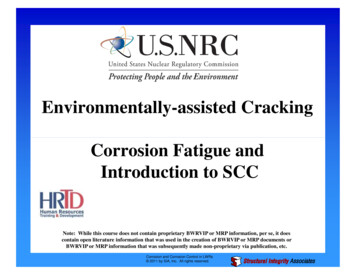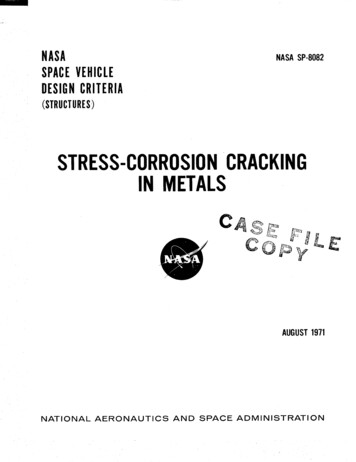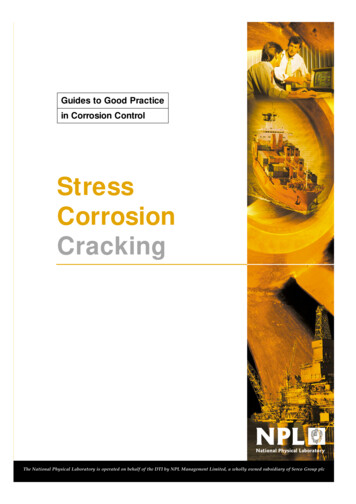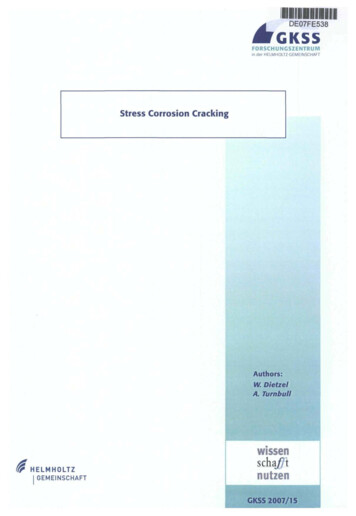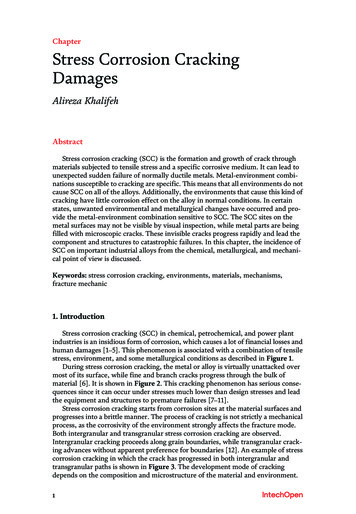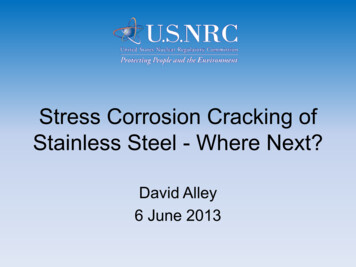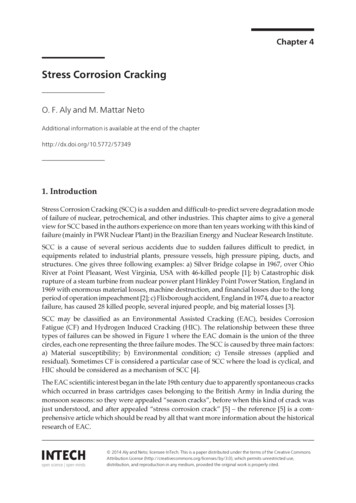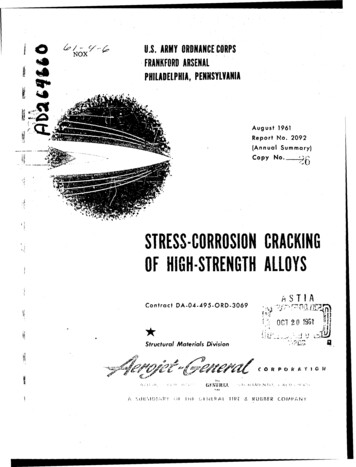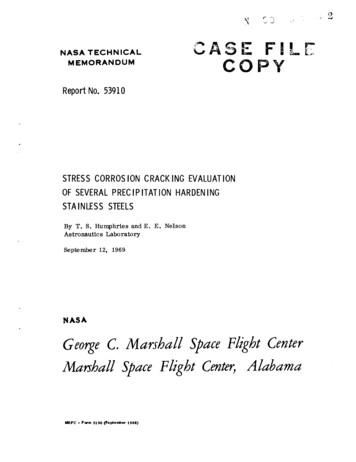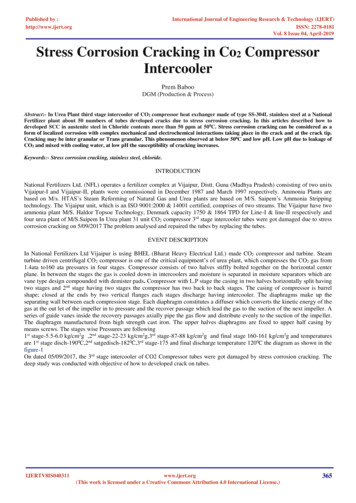
Transcription
Published by :http://www.ijert.orgInternational Journal of Engineering Research & Technology (IJERT)ISSN: 2278-0181Vol. 8 Issue 04, April-2019Stress Corrosion Cracking in Co2 CompressorIntercoolerPrem BabooDGM (Production & Process)Abstract:- In Urea Plant third stage intercooler of CO2 compressor heat exchanger made of type SS-304L stainless steel at a NationalFertilizer plant about 50 numbers of tubes developed cracks due to stress corrosion cracking. In this articles described how todeveloped SCC in austenite steel in Chloride contents more than 50 ppm at 50 0C. Stress corrosion cracking can be considered as aform of localized corrosion with complex mechanical and electrochemical interactions taking place in the crack and at the crack tip.Cracking may be inter granular or Trans granular. This phenomenon observed at below 500C and low pH. Low pH due to leakage ofCO2 and mixed with cooling water, at low pH the susceptibility of cracking increases.Keywords:- Stress corrosion cracking, stainless steel, chloride.INTRODUCTIONNational Fertilizers Ltd, (NFL) operates a fertilizer complex at Vijaipur, Distt. Guna (Madhya Pradesh) consisting of two unitsVijaipur-I and Vijaipur-II, plants were commissioned in December 1987 and March 1997 respectively. Ammonia Plants arebased on M/s. HTAS’s Steam Reforming of Natural Gas and Urea plants are based on M/S. Saipem’s Ammonia Strippingtechnology. The Vijaipur unit, which is an ISO 9001:2000 & 14001 certified, comprises of two streams. The Vijaipur have twoammonia plant M/S. Haldor Topsoe Technology, Denmark capacity 1750 & 1864 TPD for Line-I & line-II respectively andfour urea plant of M/S.Saipem In Urea plant 31 unit CO2 compressor 3rd stage intercooler tubes were got damaged due to stresscorrosion cracking on 5/09/2017 The problem analysed and repaired the tubes by replacing the tubes.EVENT DESCRIPTIONIn National Fertilizers Ltd Vijaipur is using BHEL (Bharat Heavy Electrical Ltd.) made CO2 compressor and turbine. Steamturbine driven centrifugal CO2 compressor is one of the critical equipment’s of urea plant, which compresses the CO2 gas from1.4ata to160 ata pressures in four stages. Compressor consists of two halves stiffly bolted together on the horizontal centerplane. In between the stages the gas is cooled down in intercoolers and moisture is separated in moisture separators which arevane type design compounded with demister pads. Compressor with L.P stage the casing in two halves horizontally split havingtwo stages and 2nd stage having two stages the compressor has two back to back stages. The casing of compressor is barrelshape; closed at the ends by two vertical flanges each stages discharge having intercooler. The diaphragms make up theseparating wall between each compression stage. Each diaphragm constitutes a diffuser which converts the kinetic energy of thegas at the out let of the impeller in to pressure and the recover passage which lead the gas to the suction of the next impeller. Aseries of guide vanes inside the recovery passages axially pipe the gas flow and distribute evenly to the suction of the impeller.The diaphragm manufactured from high strength cast iron. The upper halves diaphragms are fixed to upper half casing bymeans screws. The stages wise Pressures are following1st stage-5.5-6.0 kg/cm2g ,2nd stage-22-23 kg/cm2g,3rd stage-87-88 kg/cm2g and final stage 160-161 kg/cm2g and temperaturesare 1st stage disch-1900C,2nd satgedisch-1820C,3rd stage-175 and final discharge temperature 120 0C the diagram as shown in thefigure-1On dated 05/09/2017, the 3rd stage intercooler of CO2 Compressor tubes were got damaged by stress corrosion cracking. Thedeep study was conducted with objective of how to developed crack on tubes.IJERTV8IS040311www.ijert.org(This work is licensed under a Creative Commons Attribution 4.0 International License.)365
Published by :http://www.ijert.orgInternational Journal of Engineering Research & Technology (IJERT)ISSN: 2278-0181Vol. 8 Issue 04, April-2019Fig-1(process Flow diagram of CO2Compressor)Heat Exchanger(31-E-27) detailSr.No.1234ParametersFluidInlet Temperature, 0C0Outlet Temperature, C2Pressure, kg/cm25Surface Area, M678910111213Total No. of TubesNo of PassTube Length, mmTube ,ID, mmTube OD, mmPitch, mmHeat duty, K.Cal/hrMOCShell SideTube sideCooling 0CS, 516Gr701304LTable-1(Heat Exchanger Detail)IJERTV8IS040311www.ijert.org(This work is licensed under a Creative Commons Attribution 4.0 International License.)366
Published by :http://www.ijert.orgInternational Journal of Engineering Research & Technology (IJERT)ISSN: 2278-0181Vol. 8 Issue 04, April-2019THEORY BEHIND CRACKS DEVELOPED IN TUBES.The intercooler tubes made up of SS-304L(Cr-18%Ni-8.0%), the SS-304L is a type of Austenite stainless steel. The addition ofnickel has a beneficial influence on the corrosion resistance of ferrite steels. But the Nickel affinity to connect with chloridesand make Nickel chloride and HCl and some minor impurity in metal like sulphur causing stress corrosion cracking. In CO2compressor 3rd stage intercooler tube side having CO2 and shell side having cooling water. The presence of some impurity likesulphur and chlorine in a moist environment at elevated temperatures Stress corrosion cracking is an electrochemical oxidationreduction process, which occurs within localized deeps on the surface of metals coated with a passive film. This is true thehigher nickel (and molybdenum) content makes type 304L/316L more resistant to SCC but 304L there is no molybdenumcontents. Anodic reactions inside the crack. This reaction due the damaged of passive film inside shell side of heat exchanger bylow pH in initial stage of minor leakages. The Heat exchanger was opened and examined the tubes deposition scrapped and sentto lab for analysis of yellowish deposition (as shown in the figure-3) - found following resultNiCl2-17.3%, HCl-12%, Fe(OH)2-11.4%,Ophosphate-7.8%,ZnO-3.7%,Rest-Iron Oxides and silt. The chemical reactions are asfollowing.Fe Fe2 2e- (dissolution of iron).The electrons given up by the anode flow to the cathode where they are discharged in theCatholic reaction:½ O2 H2O 2e- 2(OH-)As a result of these reactions the electrolyte enclosed in the pit gains positive electrical charge in contrast to the electrolytesurrounding the pit, which becomes negatively charged. The positively charged pit attracts negative ions of chlorine Cl increasing acidity of the electrolyte according to the reaction:FeCl2 2H2O Fe(OH)2 2HClCl2 Ni NiCl2NiCl2 2H2O Ni (OH) 2 2HClFig-2 (31 E-27 CO2 3rd stage intercooler)In initial stage of tube leakages, the tube side CO2 mixed with shell side cooling water to formed carbonic acid and leading toacidic environment as following reaction. The gas CO2 is quite soluble in water in which more than 99% exists as thedissolved gas and less than 1% as carbonic acid H 2CO3, which partly dissociates to give H , HCO 3 , and CO 3 2 . Thesubsequent contributions deal with the central role CO 2 whereas here we restrict ourselves to the reaction between CO 2 andwater.CO2 H2O H2CO3PH of the shell inside the shell side decreases from 7.2 to 4.5, which causes further acceleration of corrosion process. Large ratiobetween the anode and cathode areas favours increase of the corrosion rate. Corrosion products Fe (OH)3 form around the pitresulting in further separation of its electrolyte. Due to high pressure and temperature at low pH cracks were developed ontubes. Mechanical damage of the passive film was caused by scratches. Anodic reaction starts on the metal surface exposed tothe electrolyte. The passivity surrounding surface is act as the cathode. Non-homogeneous environment may dissolve thepassive film at certain locations where initial pits form.IJERTV8IS040311www.ijert.org(This work is licensed under a Creative Commons Attribution 4.0 International License.)367
Published by :http://www.ijert.orgInternational Journal of Engineering Research & Technology (IJERT)ISSN: 2278-0181Vol. 8 Issue 04, April-2019Fig-3 (deposition on shell side)Sr. No.1234Type of SteelAISI 316AISI 304AISI 304LDuplex 10.0--8.0-10.0--5.0-6.02-3Table-2(Stainless steel te08/05/2017UnitSr.No.ParametersValue1pH7.0 – 7.32Turbidity21.6NTU3Conductivity1850µS/cm4Free Cl2 as Cl20.39mg/l5Phosphate as PO44.8mg/l6Total Alkalinity as CaCO3226mg/l7Total Hardness as CaCO3773mg/l8Ca Hardness as CaCO3562mg/l9Mg Hardness as CaCO3248mg/l10Silica as SiO297mg/l11Total Ammonia As NH336mg/l12Chloride as CL198mg/l13Sulphate as SO4-mg/l14Iron as Fe-mg/l15Zinc as Zn0.23mg/l16Cycle of concentration MgH7.3Si,%1.01.01.00.35-0.4Table-3(Cooling water analysis)IJERTV8IS040311www.ijert.org(This work is licensed under a Creative Commons Attribution 4.0 International License.)368
Published by :http://www.ijert.orgInternational Journal of Engineering Research & Technology (IJERT)ISSN: 2278-0181Vol. 8 Issue 04, April-2019Stress Corrosion Cracking (SCC) is the progressive cracking of metals and alloys caused by the combined effect of SCC-ProneMicrostructure, Temperature, Pressure and environments .Tensile Stresses High Enough to Induce SCC: sources of stress: SCCFacilitating Environs: chloride, hydroxide, carbonate, bicarbonate, ammonia, aerated water, acetate, thiosulphate, phosphate,polythionate, and methanol. Temperature and Time exacerbate the effect of all the above causes. Acting alone, stresses orcorrosive ambiences cannot induce SCC. SCC-infested metals demonstrate trans-granular or inter-granular cracks as shown inthe figure-4.The affected material may fail without displaying any symptoms of an impending failure. Cracks penetrate deepinto the material while the surface remains unaffected and the material fails with meager loss of material.Fig-4 (SCC demonstration diagram), taken from logo.png.CONCLUSIONS:The SS 304L stainless steel tube cracked by trans granular stress corrosion cracking due to the presence of some impurity likesulphur and chlorine in a moist environment at elevated temperatures. The cracked tube section exhibited an equatedmicrostructure without any evidence of sensitization or other material deficiencies. This is true the higher nickel (andmolybdenum) content makes type 316/316L more resistant to SCC. In 304L molybdenum contents is zero. But in sample theNickel Chloride found more. This is the evidence of Nickel contact with chloride made acidic environment and due to highpressure and temperature cracks are developed. Vibration also found in the equipment this can also lead to cracking.REFERENCES[1][2][3][4]The Corrosion behaviour of duplex stainless steel in Chlorine solutions by Aleksandra Kocijan, rtomir Donik, Monika Jenko Materiali inTehnologije / Materials and technology 43 (2009) 4, 195–199.Corrosive effect of chloride on metal by Fong yuan Ma, www.intechpenMicrostructure and surface treatment of 304 of stainless steel for electronic packaging by Chu Hsuan sha, Journal of electronic is work is licensed under a Creative Commons Attribution 4.0 International License.)369
In this articles described how to developed SCC in austenite steel in Chloride contents more than 50 ppm at 500C. Stress corrosion cracking can be considered as a form of localized corrosion with complex mechanical and electrochemical interactions taking place in the crack and at the crack tip. Cracking may be inter granular or Trans granular.
